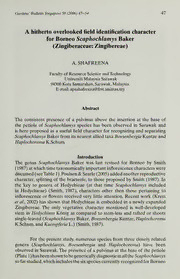
A hitherto overlooked field identification character for Bornean Scaphochlamys Baker PDF
Preview A hitherto overlooked field identification character for Bornean Scaphochlamys Baker
Gardens'Bulletin Singapore58 (2006) 47-54 47 A hitherto overlooked field identification character for Borneo Scaphochlamys Baker (Zingiberaceae: Zingibereae) SHAFREENA A. Faculty ofResource Science andTechnology Universiti Malaysia Sarawak 94300 Kota Samarahan,Sarawak,Malaysia. E-mail: [email protected] Abstract The consistent presence of a pulvinus above the insertion at the base of the petiole of Scaphochlamys species has been observed in Sarawak and is here proposed as a useful field character for recognizing and separating Scaphochlamys Baker from its nearest allied taxa Boesenbergia Kuntze and Haplochorema K.Schum. Introduction The genus Scaphochlamys Baker was last revised for Borneo by Smith (1987) atwhich time taxonomicallyimportant inflorescence characterswere & discussed (seeTable 1).Poulsen Searle (2005) addedanotherreproductive character, splitting of the bracteole, to those proposed by Smith (1987). In the key to genera of Hedychieae (at that time Scaphochlamys included in Hedychieae) (Smith, 1987), characters other then those pertaining to inflorescence or flowers received very little attention. Recent work (Kress et ai, 2002) has shown that Hedychieae is embedded in a newly expanded Zingibereae. The only vegetative character mentioned is well-developed stem in Hedychium Konig as compared to stem-less and tufted or shoots single-leaved (Scaphochlamys Baker, Boesenbergia Kuntze, Haplochorema K.Schum. and Kaempferia L.) (Smith, 1987). For the present study, numerous species from three closely related genera (Scaphochlamys, Boesenbergia and Haplochorema) have been observed in Sarawak.The presence of a pulvinus at the base of the petiole (Plate1)hasbeenshowntobegenericallydiagnosticinalltheScaphochlamys sofarstudied,whichincludesthesixspeciescurrentlyrecognizedforBorneo 48 Gard.Bull.Singapore58(2006) and at least a further 25 unidentified and seemingly novel taxa revealed during the first author's ongoing studies in Borneo. This is a very useful character especially if plants are not in flowering at the time of collection since assigning sterile individuals to one of the three above genera is often problematic. Despite our confidence in the diagnostic pulvinate petiole, care still needs to be exercised when examining Boesenbergia and Haplochorema & since the insertion of the leaves can appear to be pulvinate (Plates 2 3). Careful comparison with the true pulvinate petiole of Scaphochlamys reveals that in Scaphochlamys the pulvinus is situated above the insertion ofthe petiole (Plate 4). Scaphochlamys and its allied genera look very similar in the vegetative state.Thus,the presence ofpulvinus will make determining these closely related taxa easier at the genus level. Plate L Scaphochlamyssp. (Boyce & Shafreena ZI-157):note the pulvinatepetioles. ScaphochochlamysinBorneo 49 Plate 3. Haplochorema magnum R.M.Sm. showing leaf insertion (Boyce & Shafreena ZI- 1013) Plate 4. Scaphochlamyspolyphylla (K. Schum.) B.L. Burtt & R.M. Sm.: note many leaves eachwith apulvinate petiole (Boyce & Shafreena ZI-904) j 52 Gard.Bull.Singapore58(2006 A comparison ofinflorescence characters among Scaphochlamys and allied genera (based on Smith, 1987; Poulsen & Searle, 2005) and additional characters from this study are set out inTable 1 below. Table 1. Comparative table of inflorescence and vegetative characters of Scaphochlamys, Boesenbergia and Haplochorema. Character Scdphochldinys Boesenbergia. Haplochoreifia, Inflorescence bract Spiral Distichous Distichous arrangement Flowering mode Acropetalous Basipetalous Basipetalous nuwci diidiigCiiiciiL ounidiy OUlll11cotlny/ First bracteole Moreorlesskeeled, Boat-shaped, Boat-shapedor (shape and arisingoppositebract arising at right split,arisingat position) angle to bract right angle tobract Bracteole splitting Split tobase Split to base Splitto2A Labellum Bilobed or entire, Usually saccate, Bilobed or lobes overlapping rarely bilobed, emarginated,flat neverflat Base ofthecae Withvery shortfree Spurless Spurless basal spurs Pulvinus Present Absent Absent Acknowledgements We wish to express our thanks for the collaboration and support of the Sarawak Forestry Department, notably Datu Cheong Ek Choon, the Sarawak Biodiversity Centre, in particular Datin Eileen Yen Ee Lee and the Forest Research Centre (Kuching), especially L.C.J. Julaihi Abdullah. The second author wishes to thank Datuk Amar (Dr) Leonard Linggi Tun Jugah, Graeme Brown and Dr Timothy Hatch of Malesiana Tropicals Sdn Bhd for their considerable support and funding of fieldwork in Sarawak. The first author wishes to thank Universiti Malaysia Sarawak for the grant awarded [01(102)/454/2004(191)] for funding this research and Jeland ak Kisai of MalesianaTropicals for his invaluable assistance in the field. ScaphochochlamysinBorneo 53 References Kress,W.J., Prince, L.M. & Williams, KJ. (2002). The phylogeny and a new classification of the gingers (Zingiberaceae): Evidence from molecular data.American Journal ofBotany 89: 1682-1696. & Poulsen,A.D. Searle,R.J.2005. Scaphochlamyscalcicola (Zingiberaceae): a new and unusual species from Borneo. Gardens' Bulletin Singapore 57: 29-35. A Smith, R.M. (1987). review of Bornean Zingiberaceae: 3 (Hedychieae). Notes RoyalBotanic Garden Edinburgh 44: 203-232.
